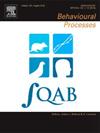Comparative analysis of tracking and behavioral patterns between wild-type and genetically modified fruit flies using computer vision and statistical methods
IF 1.3
4区 生物学
Q4 BEHAVIORAL SCIENCES
引用次数: 0
Abstract
Collective animal behavior occurs in groups and swarms at almost every biological scale, from single-celled organisms to the largest animals on Earth. The intriguing mysteries behind these group behaviors have attracted many scholars, and while it is known that models can reproduce qualitative features of such complex behaviors, this requires data from real animals to demonstrate, and obtaining data on the exact features of these groups is tricky. In this paper, we propose the Hidden Markov Unscented Tracker (HMUT), which combines the state prediction capability of HMM and the high-precision nonlinear processing capability of UKF. This prediction-driven tracking mechanism enables HMUT to quickly adjust tracking strategies when facing sudden changes in target motion direction or rapid changes in speed, reducing the risk of tracking loss. Videos of fruit fly swarm movement in an enclosed environment are captured using stereo cameras. For the captured fruit fly images, the thresholded AKAZE algorithm is first used to detect the positions of individual fruit flies in the images, and the motion of the fruit flies is modeled using a multidimensional hidden Markov model (HMM). Tracking is then performed using the Unscented Kalman Filter algorithm to obtain the flight trajectories of the fruit flies in two camera views. Finally, 3D reconstruction of the trajectories in both views is achieved through polar coordinate constraints, resulting in 3D motion data of the fruit flies. Additionally, the efficiency and accuracy of the proposed algorithm are evaluated by simulating fruit fly swarm movement using the Boids algorithm. Finally, based on the tracked fruit fly flight data, behavioral characteristics of the fruit flies are analyzed from two perspectives. The first is a statistical analysis of the differences between the two behaviors. The second dimension involves clustering trajectory similarity using the DTW method based on fruit fly flight trajectories, further analyzing the similarity within clusters and differences between clusters.
利用计算机视觉和统计方法对野生型果蝇和转基因果蝇的追踪和行为模式进行比较分析。
从单细胞生物到地球上最大的动物,几乎所有生物规模的群体和蜂群都会出现动物集体行为。这些群体行为背后引人入胜的奥秘吸引了许多学者,虽然众所周知模型可以再现这种复杂行为的定性特征,但这需要真实动物的数据来证明,而获取这些群体确切特征的数据非常棘手。这种预测驱动的跟踪机制使 HMUT 能够在面对目标运动方向突变或速度快速变化时快速调整跟踪策略,从而降低跟踪损失的风险。使用立体摄像机捕捉果蝇群在封闭环境中的运动视频。对于捕捉到的果蝇图像,首先使用阈值 AKAZE 算法检测图像中单个果蝇的位置,并使用多维隐马尔可夫模型(HMM)对果蝇的运动进行建模。然后使用无痕卡尔曼滤波算法进行跟踪,以获得果蝇在两个摄像机视图中的飞行轨迹。最后,通过极坐标约束对两个视图中的轨迹进行三维重建,从而得到果蝇的三维运动数据。此外,通过使用 Boids 算法模拟果蝇群的运动,评估了所提算法的效率和准确性。最后,根据跟踪的果蝇飞行数据,从两个方面分析了果蝇的行为特征。首先是对两种行为之间的差异进行统计分析。第二个维度是根据果蝇飞行轨迹,使用 DTW 方法对轨迹相似性进行聚类,进一步分析聚类内部的相似性和聚类之间的差异。
本文章由计算机程序翻译,如有差异,请以英文原文为准。
求助全文
约1分钟内获得全文
求助全文
来源期刊

Behavioural Processes
生物-动物学
CiteScore
2.70
自引率
7.70%
发文量
144
审稿时长
4-8 weeks
期刊介绍:
Behavioural Processes is dedicated to the publication of high-quality original research on animal behaviour from any theoretical perspective. It welcomes contributions that consider animal behaviour from behavioural analytic, cognitive, ethological, ecological and evolutionary points of view. This list is not intended to be exhaustive, and papers that integrate theory and methodology across disciplines are particularly welcome.
 求助内容:
求助内容: 应助结果提醒方式:
应助结果提醒方式:


